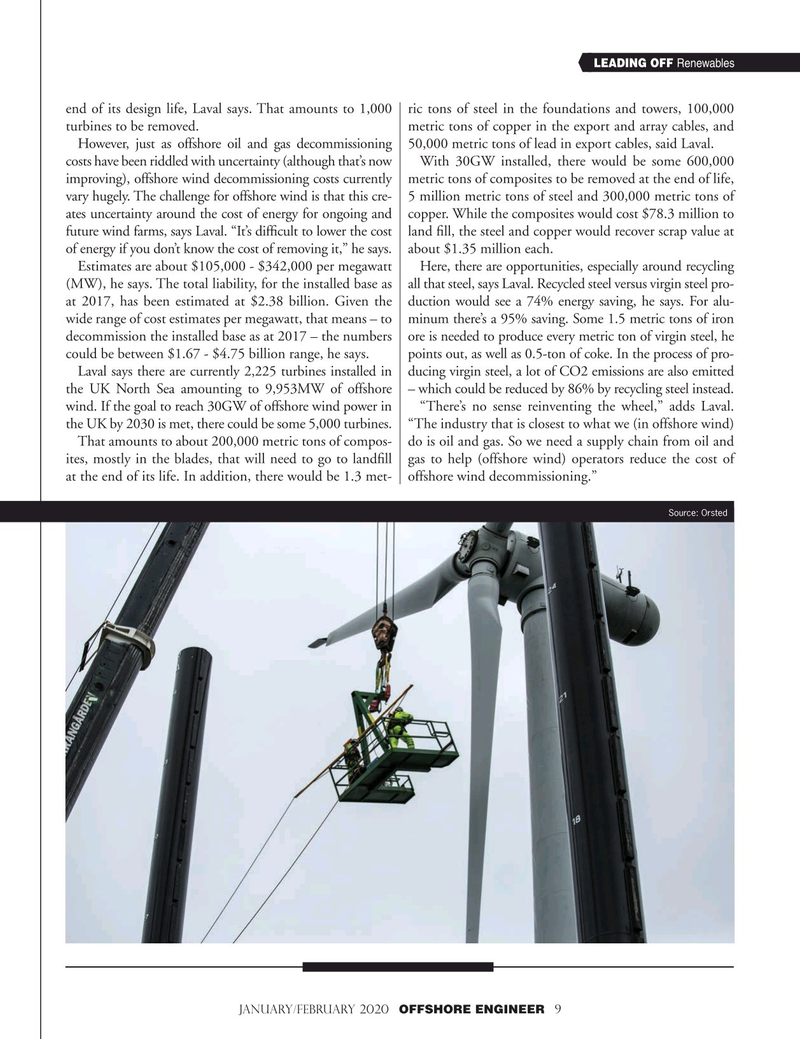
Page 9: of Offshore Engineer Magazine (Jan/Feb 2020)
Read this page in Pdf, Flash or Html5 edition of Jan/Feb 2020 Offshore Engineer Magazine
LEADING OFF Renewables end of its design life, Laval says. That amounts to 1,000 ric tons of steel in the foundations and towers, 100,000 turbines to be removed. metric tons of copper in the export and array cables, and
However, just as offshore oil and gas decommissioning 50,000 metric tons of lead in export cables, said Laval. costs have been riddled with uncertainty (although that’s now With 30GW installed, there would be some 600,000 improving), offshore wind decommissioning costs currently metric tons of composites to be removed at the end of life, vary hugely. The challenge for offshore wind is that this cre- 5 million metric tons of steel and 300,000 metric tons of ates uncertainty around the cost of energy for ongoing and copper. While the composites would cost $78.3 million to future wind farms, says Laval. “It’s dif? cult to lower the cost land ? ll, the steel and copper would recover scrap value at of energy if you don’t know the cost of removing it,” he says. about $1.35 million each.
Estimates are about $105,000 - $342,000 per megawatt Here, there are opportunities, especially around recycling (MW), he says. The total liability, for the installed base as all that steel, says Laval. Recycled steel versus virgin steel pro- at 2017, has been estimated at $2.38 billion. Given the duction would see a 74% energy saving, he says. For alu- wide range of cost estimates per megawatt, that means – to minum there’s a 95% saving. Some 1.5 metric tons of iron decommission the installed base as at 2017 – the numbers ore is needed to produce every metric ton of virgin steel, he could be between $1.67 - $4.75 billion range, he says. points out, as well as 0.5-ton of coke. In the process of pro-
Laval says there are currently 2,225 turbines installed in ducing virgin steel, a lot of CO2 emissions are also emitted the UK North Sea amounting to 9,953MW of offshore – which could be reduced by 86% by recycling steel instead. wind. If the goal to reach 30GW of offshore wind power in “There’s no sense reinventing the wheel,” adds Laval. the UK by 2030 is met, there could be some 5,000 turbines. “The industry that is closest to what we (in offshore wind)
That amounts to about 200,000 metric tons of compos- do is oil and gas. So we need a supply chain from oil and ites, mostly in the blades, that will need to go to land? ll gas to help (offshore wind) operators reduce the cost of at the end of its life. In addition, there would be 1.3 met- offshore wind decommissioning.”
Source: Orsted
JANUARY/FEBRUARY 2020 OFFSHORE ENGINEER 9

 8
8

 10
10